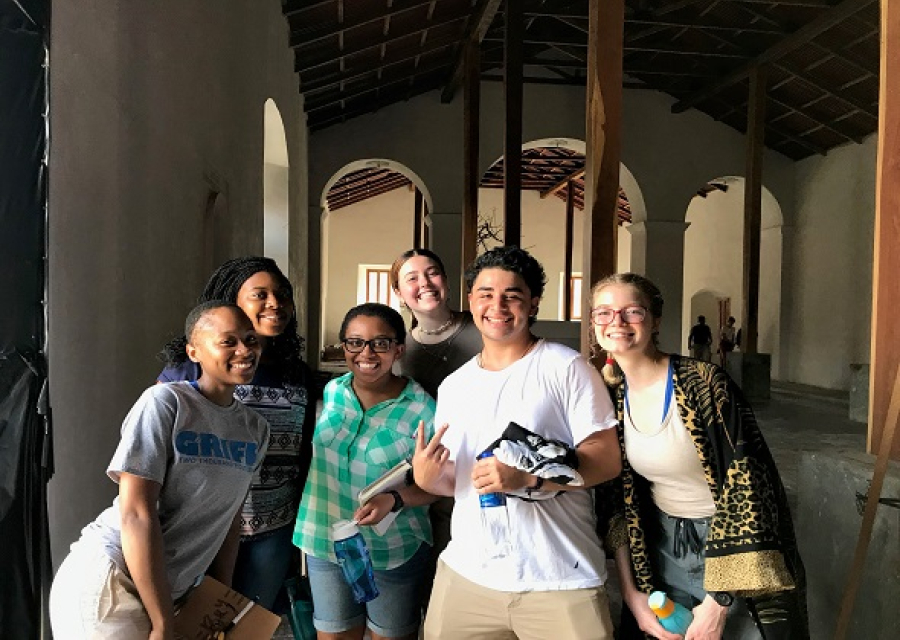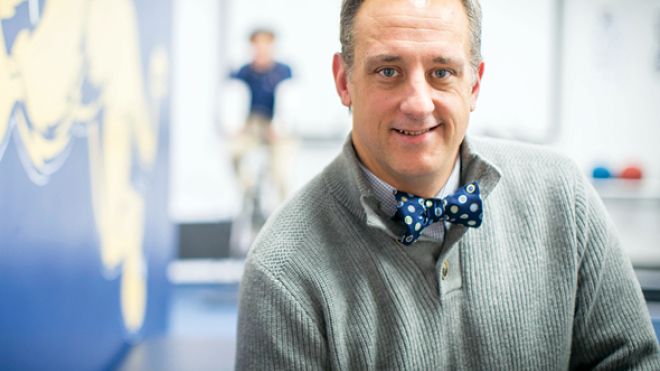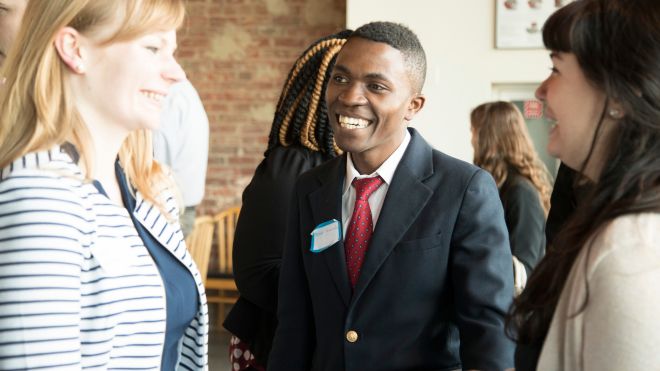
Read reflections below from members of the Campus Ministry-led immersion trip to El Salvador and the U.S./Mexico border in Nogales, AZ and Nogales, Sonora, Mexico.
Kaitlyn Buehlmann wrote:
"We visited Program Velasco, a non-profit with a goal to interrupt the cycle of poverty and inequality through a variety of services such as a preschool, women’s empowerment programs, vocational training, financial literacy classes and microloans. After meeting with one of the co-founders and a social worker on staff, we had the opportunity to meet with Anna María, a woman who has directly benefited from the services Program Velasco has to offer. As a mother of five, she first became acquainted with the center when her daughters received scholarships to attend the preschool. She then decided to take advantage of one of the free classes that offered job training and financial literacy skills, which enabled her to open her own bakery.
We toured the Service to Migrant Center. This government agency is the first stop for migrants who have been recently deported back to El Salvador. When they arrive, migrants are given an intake interview and connected with other government services to help ease their transition back into Salvadoran society. The work that’s being done there has been recognized by surrounding countries as a model for the reintegration of migrants who have been recently deported.
We visited the National Cathedral where St. Oscar Romero served as archbishop and is now buried, and then took a tour of his home and visited Divine Providence Chapel where he was assassinated. It was powerful to stand in these spaces and learn more about his life and impact on the Salvadoran people.
We heard from two women from COFAMIDE, or the Committee of Family Members of Migrants who have Died or Disappeared. They both shared their experience of having a child who had died while attempting to migrate to the U.S. Their stories moved many in the room to tears but also inspired us with their resilience.
At the University of Central America, the Jesuit University where six Jesuit priests, their housekeeper and her daughter were killed during the Civil War in 1989, we visited the museum as well as the rose garden that was planted in their memory. This was a very moving space for all of us, especially as a group from a fellow Jesuit institution in the U.S.
The afternoon wrapped with a conversation with Kevin Yonkers, the director of the Casa de las Americas, an innovative study abroad program in San Salvador. This program combines both rigorous academics and hands-on experiences accompanying those on the margins.
We spent two nights in a small community called Arcatao, where we lived in small groups with local families and toured the Museum of Historical Memory. Arcatao is a community that saw much conflict during the war, so the visit to the museum was very informative but full of many heavy stories. We heard from Oscar, an Arcatao native who attempted to make the journey to the U.S. twice in 2000 with hopes of providing his family with a better life, but he was deported both times. This was the first time Oscar had shared his experience with anyone and the group was truly touched by his story.
The next morning, we departed for an early hike up a mountain to La Cañada, where local residents fled during the Civil War when they were being persecuted by the military. When we arrived to the top, we took a tour of tatús, the caves that people used to stay safe from bombings and attacks during the wars. It was a very challenging climb but we were motivated by thinking of all the people who took this same route under much more strenuous conditions.
Later that afternoon we met with the Historical Memory Committee of Arcatao and heard more about what the members experienced during the war. At the end, they explained that they were sharing these stories to ensure the truth of what occurred during the war is not forgotten. Their hope is that we will carry the stories we’ve heard with us and that hearing them will motivate us to work for peace and justice in our own community to ensure that this never happens again. Seeing their resilience and dedication to this cause was quite moving for all of us.
We concluded our time in El Salvador with a stop at the Center for Peace through the Arts in Suchitoto run by Sister Peggy O’Neill, a vivacious nun who has lived in El Salvador for more than 30 years. The center uses the power of the arts to promote peace and healing, especially among the children of survivors of the war.
When we arrived in Tucson, we had an orientation with Joanna Williams, one of the staff members at the Kino Border Initiative. It was a good chance to learn more about what we would be experiencing while on the border. After, we drove out to the guest house in Nogales. It was really surprising to see the change in environment - from the lush greenery and mountains of Central America to the dry desert climate of Arizona. After seeing the country that many migrants come from, one can only imagine how drastic this change must seem to them too.
Later we headed out to Mass (in Spanish) at a local parish. The church is located on a hill from which you can see both the U.S. and Mexican sides of the border. It was nice to have the opportunity to sit, pray and reflect during the halfway point of our trip.
The next day, we crossed into Mexico for the first time and spent the day working at the Comedor, a soup kitchen and aid center the Kino Border Initiative runs for migrants in Nogales. We helped serve the morning and afternoon meals, as well as talked to the families that were passing through. The majority of the families we interacted with were waiting to request asylum in the U.S. However, due to the remain in Mexico policy, when these individuals arrive at the port of entry and present themselves for asylum, the U.S. officials tell them that there is no room and that they have to wait in line to even present their case. Based on the conversations we had with folks at the Comedor, the average wait time for most of these families was approximately three months. With no home to stay in and no employment opportunities, many stay at local boarding houses and receive their meals from Kino. In addition to these families, we also met a group of individuals at the Comedor who had been deported earlier that very same day, some of whom had been living in the U.S. for decades.
We went on a hike in Arivaca, an area where migrants frequently pass. Even with the mild weather that day, the sun was beating down on us and with the uneven terrain, plants with prickers and winding pathways, it’s easy to understand how challenging a multi-day hike through this environment would be. As we walked through the area, we saw belongings that had been discarded by migrants on their journeys - from backpacks, to cans of food, to a child’s sweatshirt. It was difficult to not think of all those who had passed this way before us and all those who were crossing through the dessert at that very moment.
After our hike, we drove into Tucson to witness Operation Streamline, a process in which migrants are sentenced for entering the U.S. without clearance. Those we witnessed took a plea accepting the misdemeanor charge of unlawfully entering the country. We sat in the courtroom where 75 migrants came before the judge, eight at a time, shackled at their hands, waists and ankles, and accepted the charges brought against them. Afterwards, we had a chance to talk with one of the judges and reflect on what we had just witnessed.
We had dinner with an asylum seeker named Hans at Casa Mariposa. While we enjoyed a home cooked meal, he told us how he had made the decision to migrate to the U.S. in an attempt to escape the violence that he had experienced in Peru and Mexico.
One of the goals of the Kino Border Initiative is to complicate our understanding of migration and learn about it from many sides, so on Wednesday morning we went on a visit to Border Patrol, where we heard officers give their perspectives on migration. The officers showed us a presentation and then gave us a tour of the premises.
We headed back into Mexico to spend some more time with the families that we had met earlier in the week. Since many of the families wait to present for asylum for months, many spend their afternoons at a nearby basketball court. We played basketball, colored and talked with the kids and families. We later went to Casa Nazaret, a women’s shelter run by the Kino Border Initiative for mothers traveling with their children. We had the opportunity to hear from the women about why they made the decision to migrate, as well as their experiences on the border.”
The Canisius delegation concluded their immersion with Mass and created an action plan for sharing their experiences when they return home.
Morgan Morris ’21 wrote:
"My transformative moment was when we went to see the border wall. Before going on this immersion trip, I knew how the U.S. viewed immigrants, refugees and asylum seekers and knew how the administration is handling what they call ‘foreigners’ and ‘potential terrorists,’ which is a problem in itself. I didn't truly understand the magnitude of how divisive the border wall was and how immigrants and refugees are suffering in this world until I saw it with my own eyes. Most people complain about going to work or school in heavy precipitation or in traffic and that's NOTHING compared to seeing a wall to separate people from searching for a better life. Seeing it gave me a greater respect for what immigrants and refugees have to go through and sacrifice to create a new beginning for themselves and their families."
Vivian Mroz ’19 wrote:
"A moment filled with grace was our visit to the Cathedral in San Salvador, El Salvador. It has beautifully decorated high ceilings and beautiful art. Downstairs is where St. Romero is buried. It was here where it hit me about what it meant for the country to have a leader like Romero killed and what it meant, even more, to have him canonized as a saint. This was my moment of grace, a thank you to Romero, who even against death threats gave the people a resource for not only news but the right to practice religion and have it mean more than just church.
My transformative moment hit me towards the very end of our trip. We were having a small Mass with Father Pete Neeley, one of the members of Kino’s education team. He said, "We celebrate the body of Christ. During every Mass celebration Jesus gives us a little bit of himself. Now no matter your religion/beliefs, I challenge you to do the same. I challenge you to give a piece of yourself to those you work with, because without knowing it that's what you did this week. You gave your time to the migrants/immigrants here on the border." This hit me in the ‘feels’ and was my motivation to continue what I had done on this trip: listen to and share stories."



